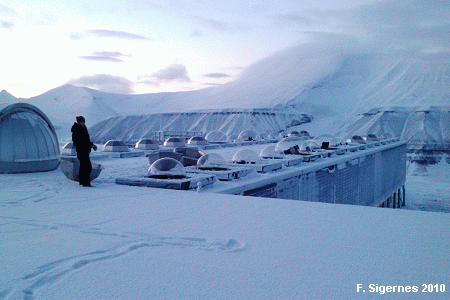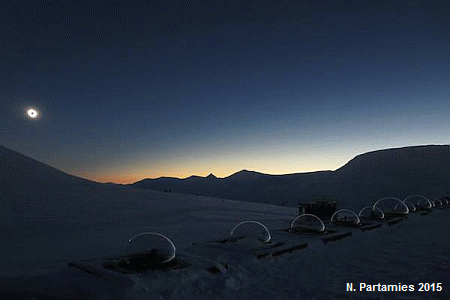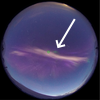 |
White aurora!
Continuum emission has been observed embedded in the dayside aurora over Svalbard.
It is a broadband emission that looks nearly white in the full-colour all-sky images, while the spectrographs see an enhancement
in the whole wavelength range from 400 to 700 nm. The continuum emission structures move and evolve with the aurora, and are
associated with both plasma and neutral heating. This may be a more dynamic cousin of STEVE ...
Read paper here. 3 July, 2025
|
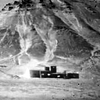 |
Fond memories 80's
Today we received a history preview from Dr. Nick Lloyd from the University of Saskatchewan in Canada of
the Auroral station in Adventdalen. The panorama dates to the winter season 1982/83...
Read more here. 3 June, 2025
|
 |
Government white paper
The Norwegian government white paper on Svalbard (2023-2024) recognizes our activity on Breinosa as a world-leading space weather infrastructure. See textbox 4.4 in Chapter 4. We are happy together with our partners for this recognition and will continue to serve and improve our aurora forecasts to the public.
Read white paper here. 19 May, 2025
|
 |
Australia joins KHO!
We are proud to announce that Western Sydney University (WSU) has joined the observatory. Dr. Greg Cohen and his team from the International Centre for Neuromorphic Systems (ICNS) are experts in event-based camera sensors. We look forward to co-operate and test the new technology on both aurora and on our hyperspectral cameras.
Visit ICNS. 14 April, 2025
|
 |
Spotlight on Optics!
Eureka! The Optica Publishing Group has chosen our paper: Near infra-red black silicon pushbroom hyperspectral imager, for inclusion in Spotlight on Optics.
Read the summary here. 9 April, 2025
|
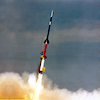 |
Coming up!
KHO is part of the upcoming NASA sounding rocket campaign named Rocket Experiment for Neutral Upwelling 3 (RENU-3). The payload is designed to measure neutral gas, ions and electrons
associated with Poleward Moving Auroral Forms (PMAFs) in the dayside Cusp. The first possible launch window is 13 - 27 of November. PI is Prof. Marc Lessard from University of New Hampshire.
AGU abstract and Nominal trajectory. 7 April, 2025
|

 |
Fram2 mission complete!
Fram2 astronauts including Norway's first vehicle commander Jannicke Mikkelsen have teamed up with UNIS space physicists.
The mission is the first human manned polar orbit commercial spaceflight. The SolarMaX citizen scientist
project are supporting the mission with simultaneous auroral ground data.
Fram2 was successfully launch at 01:46 UTC on Tuesday 1st of April 2025 from Kennedy Space Center in Florida. The mission is complete and splashdown was today at 16:19 UTC. Congratulation to Jannicke and her team! Read the latest SolarMaX updates here. 4 April, 2025
|
|
|
NEW Planeterrella!
Baptiste Katz and Olivier Falque from the University of Grenoble have installed and demonstrated our new
Planeterrella reconstructed by Prof. Jean Lilensten. It's capable of creating artificial aurora just like Kristian Birkeland did back at the turn of the 19th century.
View amazing displays recorded by Lotte van Hazendonk in the below links.
Images [ 1, 2, 3, 4] and movies [ 1, 2, 3] 5 March, 2025
|
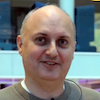 |
Asteroid impact?
Prof. II Kjellmar Oksavik strikes again on TV2 Play TikTok! He informs that the asteroid identified as 2024 YR4 discovered last Christmas, will according to calculations by NASA, luckily not hit Earth in 8 years. That is a great relief!
See TV2 TikTok. 25 February, 2025
|
 |
BBC radio visit
Listen to BBC CrowdScience episode titled: Why isn't the sky green? Katie Herlingshaw explained the sky colors and scattering.
She also guided the crew for an excursion up to the observatory. Well done, Katie!
Listen here. 21 February, 2025
|
 |
Podcast: Norways Sol-Pål!
Listen to Norwegian podcast on Spotify with our Prof. II Pål Brekke. Here he small talks about the Sun, Aurora, KHO, AGF-216, belt wagons and other space activities on Svalbard. Lots of topics are covered, even Karlsberger pub.
Romkapsel podcast: Episode 275. 16 February, 2025
|
 |
Kjellmar in Space?
View video snap of our Prof. II Kjellmar Oksavik on TV2 Play. He is dressed in a space suit for the event, explaining why we have high auroral activity the next couple of years. Excellent, Kjellmar!
See video here. 13 February, 2025
|
 |
New prototype published!
Our prototype Near-Infra Red Hyper Spectral Imager version 7 (NIR HSI v7) is now published in the journal Optics Continuum (Optica). The instrument is assembled using 3D printing.
Furthermore, it uses a new novel high speed Black Silicon CMOS image sensor.
Read paper here. 12 February, 2025
|
|
|
The Red-Sky Enigma returns
From mid-January with the return of nautical to civil twilight conditions on Svalbard, a red-purple sky color
is daily observed with the rise of the Sun - even though it's way below the horizon. This effect is due to a long period of cold temperatures
(-85oC)
in the Stratosphere over Svalbard and the mainland. As a consequence, Polar Stratospheric Clouds (PSC) are formed, ducting and scattering the solar light
into the dark illuminated polar hemisphere. The process is explained in our Red-Sky Enigma paper published back in 2005.
Read paper here. 4 February, 2025
|
 |
Observatory science highlights!
Read Katie Herlingshaw et al. (2025) extensive publication in the Journal Arctic Science on KHO highlights. A historic compilation that spans over 4 decades from the old Nordlysstasjonen in Adventdalen (1978) and up until today. Well done, Katie!
Read milestone paper. 3 February, 2025
|
|
|
HYPSO-2 works!
We are proud to report that the HYPSO-2 satellite works as planned with sharp focus on both camera systems. The improved payload consist of our designed Hyper Spectral Imager (HSI v6) and a regular RGB camera.
See stunning images in Gemini.no 31 January, 2025
|
 |
Is the Aurora disappearing from Svalbard?
Mikkel Breedveld and Stein Haaland points out that the magnetic pole moves in position and will consequently shift the
auroral oval 5-6 km South each year if the current changes in the Earth's magnetic field continues.
The question of how long we will see aurora from Svalbard is raised.
Read Svalbardposten feature article. 30 January, 2025
|




